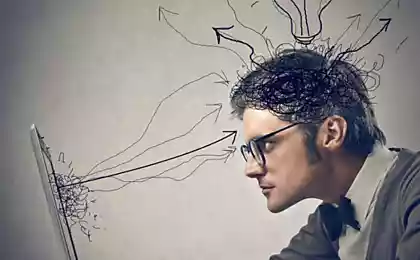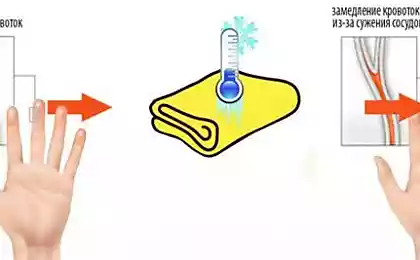656
Neurotransmitters: dopamine, norepinephrine, serotonin
Neurotransmitters is a holiday that is always with you. We constantly hear about what they give feelings of joy and pleasure, but know little about how they work.
Talk about the three most well-known neurotransmitters, without which our lives would be just disgusting.
How do the neurotransmittersEighty five million three hundred ninety eight thousand nine hundred forty eight
Nerve cells to communicate with processes — axons and dendrites. Between them a gap, the so — called synaptic cleft. This is exactly the interaction of neurons.
Neurotransmitters are synthesized in the cell and delivered to the end of the axon to the presynaptic membrane. There, under the influence of electric impulses, they fall into the synaptic cleft and activate receptors on the next neuron. After activation of receptors of the neurotransmitter back into the cell (this is called reuptake) or destroyed.
Yourself neurotransmitters are not proteins, so there is no "dopamine gene" or "gene of adrenaline." Proteins perform all the auxiliary work:
For the proper functioning of a single neurotransmitter can answer a few proteins — and, hence, several different genes.
DopamineDue to the activation of neurons in different areas of the brain, dopamine plays multiple roles.
At a basic level we get a reward for simple human pleasures — food and sex, but in General, the options for achieving satisfaction depend on the tastes of each — some "carrot" will go for the extended code, someone over on this article.
The reward system associated with learning: the person takes pleasure in his brain formed new cause-effect Association. And then, when the pleasure will pass and the question arises, how to get it again, there is a simple solution — write another article.
Dopamine looks like a great stimulant for work and study, as well as a perfect drug — with the action of dopamine accounts for the majority of drugs (amphetamine, cocaine), there is only serious side effects.
The smaller the number of repetitions, the easier a person to achieve the peak of pleasure. Such people are likely to be quite a good dinner and a good movie.
The greater the number of repetitions — and they can be up to ten or more difficult to treat. So people have to try to obtain the reward: to travel the world, conquer the mountain, do flips on the bike or put on all red state in Las Vegas. This genotype is associated with a range of migration of ancient humans from Africa to Eurasia.
There is a sad statistic: convicts in prisons for serious crimes, most often "poor" version of the DRD4.
Twenty seven million four hundred forty two thousand five hundred eighty one
NoradrenalineNorepinephrine is a neurotransmitter of wakefulness and making quick decisions. He aktiviziruyutsya under stress and in extreme situations, participates in the reaction of "fight or flight".
Norepinephrine causes a burst of energy, reduces anxiety, increases the level of aggression.
On the somatic level, under the action of noradrenaline quickens the heartbeat and increased blood pressure.
Norepinephrine — neurotransmitter of favorite surfers, snowboarders, motorcyclists and other lovers of extreme sports and their colleagues in the casinos and gaming clubs — the brain does not differentiate between real events and imaginary, so safe for life risk of losing his fortune at cards is enough to activate norepinephrine.
SerotoninWe used to hear about him as the "happiness hormone", while serotonin is not a hormone, and with "happiness" is not so clear.
Serotonin is a neurotransmitter that not so much brings positive emotions, how to reduce the susceptibility to negative. He supports the "nearby" neurotransmitters — norepinephrine and dopamine.
Serotonin is involved in motor activity, reduces pain in the background, helps the body to fight against inflammation.
Also the serotonin increases the accuracy of the transfer active signals in the brain and helps to concentrate.
With the number of repeats are also associated syndrome sudden infant mortality, aggressive behavior in the development of Alzheimer's disease and a tendency to depression.
Eighty five million seven hundred forty six thousand five hundred ninety five
Destruction of neurotransmitters The action of neurotransmitters like holiday, like everything came joyful crowd on the street to watch the fireworks. But the holiday can not (and should not) last forever, and neon rose in the night sky has to give the familiar constellations and the dawn.
To do this, the body has the function of reuptake of mediator — when a substance returns from the synaptic cleft back into the presynaptic membrane of the axon and the neurotransmitter action is terminated.
But sometimes the reverse grip is not enough, and need more effective measures — the destruction of molecules of neurotransmitter.
These functions also perform squirrel.
The COMT gene encodes the enzyme catechol‑O-methyltransferase, which destroys norepinephrine and dopamine. From working of the protein depends on how well you will cope with stressful situations.
Also the mutation of the gene COMT are associated with parkinsonism and hypertension.
Eight million nine hundred eighty two thousand one hundred ninety
The gene for the enzyme monoamine oxidase A MAOA responsible for the deactivation of the monoamines — the neurotransmitters with one amino group, which include epinephrine, norepinephrine, serotonin, melatonin, histamine, and dopamine. The better the MAOA gene, the faster neytralizuya "blurred mind", caused by stressful situation and the faster the person is able to make informed decisions.
Sometimes even the gene called MAOA "the genome of the criminal» certain gene mutations contribute to the emergence of pathological aggression. Due to the fact that the gene is on the X chromosome and girls have two copies of the gene, and the boys only one, among men are statistically more "natural born criminals".
Won't blame everything on genetics even against the "violent" gene MAOA, all difficult: a study of new Zealand scientists has shown that the relationship between gene and aggressive behavior is manifested only when there is a traumatic experience.
Understanding of the principles of the neurotransmitters allows for a fresh look at familiar emotions, mood and even reconsider ideas about what really shapes our personality.published
P. S. And remember, only by changing their consumption — together we change the world! ©
Source: geektimes.ru/company/atlasbiomed/blog/280816/
Talk about the three most well-known neurotransmitters, without which our lives would be just disgusting.
How do the neurotransmittersEighty five million three hundred ninety eight thousand nine hundred forty eight
Nerve cells to communicate with processes — axons and dendrites. Between them a gap, the so — called synaptic cleft. This is exactly the interaction of neurons.
Neurotransmitters are synthesized in the cell and delivered to the end of the axon to the presynaptic membrane. There, under the influence of electric impulses, they fall into the synaptic cleft and activate receptors on the next neuron. After activation of receptors of the neurotransmitter back into the cell (this is called reuptake) or destroyed.
Yourself neurotransmitters are not proteins, so there is no "dopamine gene" or "gene of adrenaline." Proteins perform all the auxiliary work:
- proteins-enzymes are synthesized by the neurotransmitter substance,
- carrier proteins are responsible for the delivery,
- proteins-receptors activate nerve cell.
For the proper functioning of a single neurotransmitter can answer a few proteins — and, hence, several different genes.
DopamineDue to the activation of neurons in different areas of the brain, dopamine plays multiple roles.
- First of all, it is responsible for motor activity and gives the joy of movement.
- Secondly, gives the feeling of almost childish delight of learning and the desire of novelty search.
- Thirdly, dopamine performs an important function in reward and reinforcement motivation: as soon as we do something useful for the life of the human species, neurons give us the prize — a sense of satisfaction (sometimes also called pleasure).
At a basic level we get a reward for simple human pleasures — food and sex, but in General, the options for achieving satisfaction depend on the tastes of each — some "carrot" will go for the extended code, someone over on this article.
The reward system associated with learning: the person takes pleasure in his brain formed new cause-effect Association. And then, when the pleasure will pass and the question arises, how to get it again, there is a simple solution — write another article.
Dopamine looks like a great stimulant for work and study, as well as a perfect drug — with the action of dopamine accounts for the majority of drugs (amphetamine, cocaine), there is only serious side effects.
- "Overdosing" of dopamine leads to schizophrenia (a brain is so active that it begins to manifest itself in auditory and visual hallucinations),
- disadvantage is to depressive disorder or the development of Parkinson's disease.
The smaller the number of repetitions, the easier a person to achieve the peak of pleasure. Such people are likely to be quite a good dinner and a good movie.
The greater the number of repetitions — and they can be up to ten or more difficult to treat. So people have to try to obtain the reward: to travel the world, conquer the mountain, do flips on the bike or put on all red state in Las Vegas. This genotype is associated with a range of migration of ancient humans from Africa to Eurasia.
There is a sad statistic: convicts in prisons for serious crimes, most often "poor" version of the DRD4.
Twenty seven million four hundred forty two thousand five hundred eighty one
NoradrenalineNorepinephrine is a neurotransmitter of wakefulness and making quick decisions. He aktiviziruyutsya under stress and in extreme situations, participates in the reaction of "fight or flight".
Norepinephrine causes a burst of energy, reduces anxiety, increases the level of aggression.
On the somatic level, under the action of noradrenaline quickens the heartbeat and increased blood pressure.
Norepinephrine — neurotransmitter of favorite surfers, snowboarders, motorcyclists and other lovers of extreme sports and their colleagues in the casinos and gaming clubs — the brain does not differentiate between real events and imaginary, so safe for life risk of losing his fortune at cards is enough to activate norepinephrine.
- High level norepinephrine leads to reduced vision and analytical skills,
- disadvantage — to boredom and apathy.
SerotoninWe used to hear about him as the "happiness hormone", while serotonin is not a hormone, and with "happiness" is not so clear.
Serotonin is a neurotransmitter that not so much brings positive emotions, how to reduce the susceptibility to negative. He supports the "nearby" neurotransmitters — norepinephrine and dopamine.
Serotonin is involved in motor activity, reduces pain in the background, helps the body to fight against inflammation.
Also the serotonin increases the accuracy of the transfer active signals in the brain and helps to concentrate.
- Oversupply of serotonin (for example, when taking LSD) increases the volume of the secondary signals in the brain, and having hallucinations.
- Lack of serotonin and violation of balance between positive and negative emotions — the main cause of depression.
- The longer the chain, the easier a person to keep a positive attitude and switch with negative emotions.
- The shorter — the higher the probability that a negative experience will be traumatic.
With the number of repeats are also associated syndrome sudden infant mortality, aggressive behavior in the development of Alzheimer's disease and a tendency to depression.
Eighty five million seven hundred forty six thousand five hundred ninety five
Destruction of neurotransmitters The action of neurotransmitters like holiday, like everything came joyful crowd on the street to watch the fireworks. But the holiday can not (and should not) last forever, and neon rose in the night sky has to give the familiar constellations and the dawn.
To do this, the body has the function of reuptake of mediator — when a substance returns from the synaptic cleft back into the presynaptic membrane of the axon and the neurotransmitter action is terminated.
But sometimes the reverse grip is not enough, and need more effective measures — the destruction of molecules of neurotransmitter.
These functions also perform squirrel.
The COMT gene encodes the enzyme catechol‑O-methyltransferase, which destroys norepinephrine and dopamine. From working of the protein depends on how well you will cope with stressful situations.
- Holders of active form of COMT gene warriors by nature — get low levels of dopamine in the frontal lobe of the brain, which is responsible for processing information and a pleasant feeling. Such people are better adapt to stressful situations, they are open to communication, they have a better memory. But because low levels of dopamine they get less pleasure from life, are more prone to depression, they have developed worse motor function.
- Low-activity variant of the COMT gene the situation changes on the opposite. Holders of inactive mutations have good fine motor skills, are more creative, but can not tolerate the pain, and once they get in a stressful situation, as they are immersed in irritability, impulsiveness and anxiety.
Also the mutation of the gene COMT are associated with parkinsonism and hypertension.
Eight million nine hundred eighty two thousand one hundred ninety
The gene for the enzyme monoamine oxidase A MAOA responsible for the deactivation of the monoamines — the neurotransmitters with one amino group, which include epinephrine, norepinephrine, serotonin, melatonin, histamine, and dopamine. The better the MAOA gene, the faster neytralizuya "blurred mind", caused by stressful situation and the faster the person is able to make informed decisions.
Sometimes even the gene called MAOA "the genome of the criminal» certain gene mutations contribute to the emergence of pathological aggression. Due to the fact that the gene is on the X chromosome and girls have two copies of the gene, and the boys only one, among men are statistically more "natural born criminals".
Won't blame everything on genetics even against the "violent" gene MAOA, all difficult: a study of new Zealand scientists has shown that the relationship between gene and aggressive behavior is manifested only when there is a traumatic experience.
Understanding of the principles of the neurotransmitters allows for a fresh look at familiar emotions, mood and even reconsider ideas about what really shapes our personality.published
P. S. And remember, only by changing their consumption — together we change the world! ©
Source: geektimes.ru/company/atlasbiomed/blog/280816/
John wooden: Difference between winning and success
Delicious millet pancakes with egg yolks, without the baking soda and yeast























